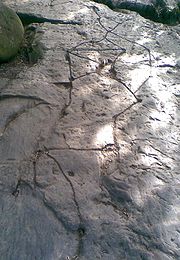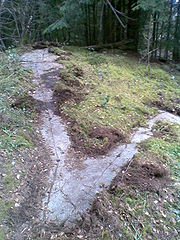
Rock cannon
Encyclopedia



Welsh language
Welsh is a member of the Brythonic branch of the Celtic languages spoken natively in Wales, by some along the Welsh border in England, and in Y Wladfa...
as a cerrig cannan, craig cannan, or in the 19th century, craig fagnel (plural: craig fagnelau; Welsh: magnel - gun, cannon), is a rock or boulder which has been bored with holes which can be partly loaded with black powder (gunpowder) and ignited to make explosive sounds during traditional celebrations. They are largely found in the slate quarrying areas of Gwynedd
Gwynedd
Gwynedd is a county in north-west Wales, named after the old Kingdom of Gwynedd. Although the second biggest in terms of geographical area, it is also one of the most sparsely populated...
in North Wales
North Wales
North Wales is the northernmost unofficial region of Wales. It is bordered to the south by the counties of Ceredigion and Powys in Mid Wales and to the east by the counties of Shropshire in the West Midlands and Cheshire in North West England...
(235 sites found up to 2001). Each cannon has a number of holes which may range from 3 to 195 (at Parc Moelyci, Sling, Tregarth
Tregarth
Tregarth is a village near Thomas Telford's A5 London to Holyhead road between the village of Bethesda and the city of Bangor in Gwynedd, North Wales.- History :...
).
The firing of rock cannon was a traditional part of social events and celebrations in north Wales from the late 18th century, accompanied by fireworks and bonfires. The cannon firing, as part of wider celebrations, often marked a national or local event, visits by royalty, or notable births and marriages.
On a national level, the marriage of Albert Edward, Prince of Wales
Edward VII of the United Kingdom
Edward VII was King of the United Kingdom and the British Dominions and Emperor of India from 22 January 1901 until his death in 1910...
to Princess Alexandra of Denmark
Alexandra of Denmark
Alexandra of Denmark was the wife of Edward VII of the United Kingdom...
in 1863 was widely celebrated, as was the Diamond Jubilee of Queen Victoria and subsequent coronations. It is recorded that the afore-mentioned marriage was celebrated at the 13 hole cannon at Trefriw
Trefriw
Trefriw is a village in Conwy County Borough, Wales. It lies on the river Conwy in North Wales, a few miles south of the site of the Roman fort of Canovium, sited at Caerhun. The parish population in 2001 was 924....
, in Gwynedd, where local newspaper stated that "Rock and metal cannons were fired in such profusion that about 8cwt of gunpowder was consumed."
The visit of the Duchess of Kent
Duchess of Kent
The Duchess of Kent is the title given to the wife of the Duke of Kent.Five women have held the title:* Jemima , daughter of Thomas Crewe, 2nd Baron Crewe, first wife of Henry Grey, 1st Duke of Kent...
to Blaenau Ffestiniog
Blaenau Ffestiniog
Blaenau Ffestiniog is a town in Gwynedd, north-west Wales. It has a population of 5,000, including Llan Ffestiniog, which makes it the third largest town in Gwynedd, behind Caernarfon & Porthmadog. Although the population reached 12,000 at the peak of the slate industry, the population fell due to...
saw a firing as late as 1951.
On a more local level cannon were fired to mark the laying of the first stone on the Ffestiniog Railway
Ffestiniog Railway
The Ffestiniog Railway is a narrow gauge heritage railway, located in Gwynedd, Wales. It is a major tourist attraction located mainly within the Snowdonia National Park....
in 1832 , its opening in 1836 , and the opening of the Moelwyn Tunnel in 1842.
In Gwynedd the Penryn
Penrhyn Quarry
The Penrhyn Slate Quarry is a slate quarry located near Bethesda in north Wales. At the end of the nineteenth century it was the world's largest slate quarry; the main pit is nearly long and deep, and it was worked by nearly 3,000 quarrymen. It has since been superseded in size by slate quarries...
, Vaynol
Vaynol
Vaynol or Y Faenol , is a country estate dating from the Tudor period, near Y Felinheli in Gwynedd, North Wales . There are of park, farmland, and gardens on the estate, with over thirty listed buildings, surrounded by a wall which is long...
, and Tanybwlch quarrying estates had large numbers of cannon.
At Betws-y-coed
Betws-y-Coed
Betws-y-Coed is a village and community in the Conwy valley in Conwy County Borough, Wales. It has a population of 534. The name Betws or Bettws is generally thought to be derived from the Anglo-Saxon Old English 'bed-hus' - i.e. a bead-house - a house of prayer, or oratory...
, in Gwynedd the river-side cannon at Pont-y-pair comprises 3 separate cannons. The largest covers an area of 9.25m x 3.22m, and comprises 53 holes. Close to it lies a second cannon, comprising just 7 holes in a single train measuring 2.7m long. A third cannon, comprising 24 holes, lies in an elevated position a little upstream, and covers an area measuring 3.5m x 1.7m. This was constructed at a different time from the other two, and is of a poor design, the holes being bored into the cleavage plane
Cleavage (geology)
This article is about rock cleavage, for cleavage in minerals see Cleavage Cleavage, in structural geology and petrology, describes a type of planar rock feature that develops as a result of deformation and metamorphism. The degree of deformation and metamorphism along with rock type determines the...
.
Llangynog
Llangynog
Llangynog lies at the confluence of the Afon Eirth and the Afon Tanat at the foot of the Berwyn range in Powys, Wales. Pop c.300It lies at the foot of the Milltir Cerrig mountain pass on the B4391 road, which runs between Llan Ffestiniog and Llanfyllin .It is surrounded by mountains and is a...
in the Berwyn range
Berwyn range
The Berwyn range is an isolated and sparsely populated area of moorland located in the north-east of Wales, roughly bounded by Llangollen in the north-east, Corwen in the north-west, Bala in the south-west, and Oswestry in the south-east.The Berwyn range also played its part in causing King Henry...
, Llandderfel near Corwen, and east Denbighshire
Denbighshire
Denbighshire is a county in north-east Wales. It is named after the historic county of Denbighshire, but has substantially different borders. Denbighshire has the distinction of being the oldest inhabited part of Wales. Pontnewydd Palaeolithic site has remains of Neanderthals from 225,000 years...
also had cannon. One site exists at Seathwaite (Lake District
Lake District
The Lake District, also commonly known as The Lakes or Lakeland, is a mountainous region in North West England. A popular holiday destination, it is famous not only for its lakes and its mountains but also for its associations with the early 19th century poetry and writings of William Wordsworth...
) and four in Cornwall
Cornwall
Cornwall is a unitary authority and ceremonial county of England, within the United Kingdom. It is bordered to the north and west by the Celtic Sea, to the south by the English Channel, and to the east by the county of Devon, over the River Tamar. Cornwall has a population of , and covers an area of...
, where they are known in Cornwall as merriment holes.
There are two basic patterns of construction. The stone may simply have a series of holes drilled at regular intervals. The ignition was carried between adjacent holes by a trail of black powder over the surface of the stone which was held in place by goose grease. A later construction had the holes linked by shallow grooves, often curved to lengthen the interval between bangs. The black powder was then laid in the grooves and covered with powdered stone to keep it in place.
The holes are typically an inch in diameter and five inches deep. Modern experiments have shown that a small amount of black powder in the hole with a powder-filled goose feather quill as a fuse, and the whole held in place by powdered slate can produce spectacular sounds and visual effects.

